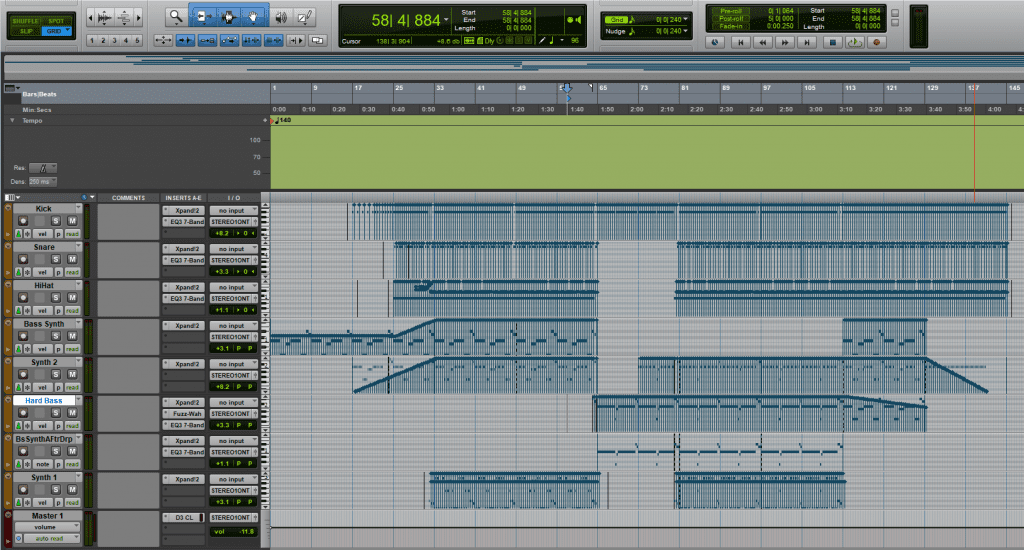
Number 2 – The ProTools Session
Number 2, which was called as such because it is the second song I made for this EP, is a 140 bpm EDM track that was created using a lot of harsh-sounding synths, a hard-hitting kick drum, a couple of build-ups, and a drop (where the rhythm/pace drastically changes in a song to improve its energy, usually after the aforementioned build up). To do this effectively, the kick used a 4 on the floor pattern for the majority of the song, with some parts, including just before the drop, where it began playing every 8th note, and then every 16th note, before stopping for a bar, and then going back to the 4 on the floor pattern. This sequencing allowed the kick drum to help the song naturally build up to the drop in the middle of the song, thus providing an extra function instead of simply keeping rhythm.
The snare and hi-hat also accompany the kick drum on the drum kit, with both rhythms being simple to sequence in. The hi-hat strikes on every 16th note, with variations in velocity to put emphasis on certain notes, while the snare strikes on every second beat 3 times before doing 2 syncopated strikes, one strike on the 8th note after the 3rd beat and the other directly on the 4th beat. Both patterns repeat throughout the song with the exception of the intro and the drop, because they are there to help keep rhythm and support the kick drum as it does the same.
There were multiple synths used on this song, all of which used riffs throughout the song, regardless of whether they were bass synths or synths on higher octaves. The bass synths all had riffs that were on the beat of the kicks, used initially to set the tempo in the intro, but then as a way to provide a loud, hard-sounding bassline during the rest of the song, which especially became the focus of the song during the drop, while the synths that moved into the higher octaves played a melodic riff to accompany the basslines, not wanting to drown it out, because if it did, then the song wouldn’t be as easy to dance to, which takes away from the intention of making it an EDM song.

Number 2 – The use of Velocity in the sequenced elements
The velocities shown above dictate where the intro, drops, and outro were located. As shown, most of the automation occurred during the songs intro/outro, to give the song a build-up into the first main section of the song, and a nice smooth outro to end the song with. The intro is important to get right, as using a build in a dance song is quite commonplace to help build tension through the use of turning 8th notes into 16th notes, which I helped to emphasize with a steadily rising velocity on the bass/melodic synths that accompanied it, making it stand out before the first main section. The outro was more of a creative choice because it was a good way to wind down on the song after the hard sections previously, which give the song a softer intro and outro in order to get warmed up to dance for the song, and some time to relax after the main parts.

Leave a Reply